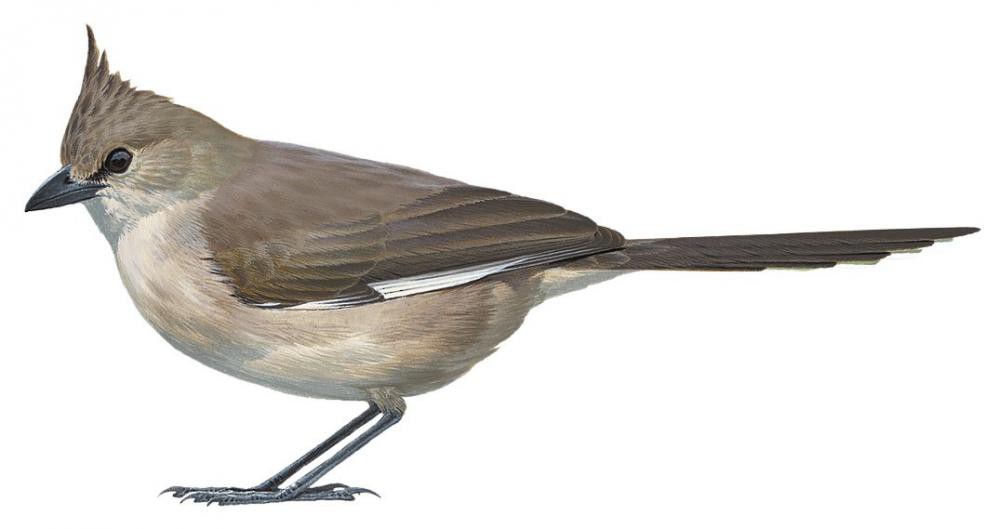Chiming Wedgebill / Psophodes occidentalis

Chiming Wedgebill
SCI Name:
Protonym: Sphenostoma cristatum occidentale Novit.Zool. 18 p.378
Taxonomy: Passeriformes / Psophodidae / Psophodes
Taxonomy Code: chiwed1
Type Locality: Day Dawn, Western Australia.
Author: Mathews
Publish Year: 1912
IUCN Status: Least Concern
DEFINITIONS
PSOPHODES
(Psophodidae; Ϯ Eastern Whipbird P. olivaceus) Gr. ψοφωδης psophōdēs noisy, full of sound < ψοφος psophos noise; "Genus. PSOPHODES*. Rostrum forte, breve, subrectum, subcompressum; culmine vix carinato, subarcuato; mandibulis integris; naribus basalibus, ovalibus, plumulis setisque frontis opertis; rictu vibrissis fortibus incumbentibus instructo. Alæ brevissimæ, rotundatæ; remigibus prima brevi, secunda tertia et quarta gradatim longioribus, quinta ad nonam inclusam fere æqualibus, longissimis. Cauda elongata, gradata. Pedes subfortes, subelongati; acrotarsiis scutellatis, paratarsiis integris. This form offers one of the greatest difficulties to the investigator of affinities. The birds that exhibit it are said to be Honey-Eaters. This we much doubt. They are found among the flowers of the Eucalypti; but this circumstance may arise as well from their being in search of the insects abounding in these flowers, as of the honey contained in them. It is strange that we have never been able to examine a tongue of these birds, although the skins are common. Their general appearance indicates much of the Shrike. The strong bristles of the rictus suggest the idea of their food being animal, and indeed originally induced Dr. Latham to place them in the Linnean Muscicapæ. The integrity of the margins of the bill, on the other hand, seems to militate against this supposition. The extreme shortness and roundness of the wing again, and the long and graduated tail, are additional characters that demand consideration. ... *ψοφος crepitus. ... 1. CREPITANS. ... Muscicapa crepitans. Lath. Ind. Orn. Supp. p. li. no. 10. Coach-whip Honey-Eater. Id. Gen. Hist. iv. p. 187. no. 43. Mr. Caley informs us that "this bird is more often heard than seen. It inhabits brushes. The loud cracking whip-like noise it makes (from whence the colonists give it the name of Coach-whip) may be heard from a great distance."" (Vigors & Horsfield 1827); "Psophodes Vigors and Horsfield, 1827, Trans. Linn. Soc. London, 15, p. 328. Type, by monotypy, Muscicapa crepitans Latham = Corvus olivaceus Latham." (Deignan in Peters 1964, X, 229).
Var. Psofodes, Phosphodes.
Synon. Phodopses, Sphenostoma.
occidentale / occidentalis
L. occidentalis western < occidens, occidentis west < occidere to set. This toponym was frequently given to taxa discovered in locations west of previously known populations.
● Cocal, Western Andes, Colombia (Dysithamnus).
● Jamaica; ex “Onocrotalus” or “Pelecanus fuscus” of Sloane 1725, “Pelican of America” of Edwards 1747, and “Pelecanus” of Browne 1756 (Pelecanus).
● TL. Day Dawn, Western Australia; "Westralian Wedgebill" (Mathews 1912) (Psophodes).
UPPERCASE: current genus
Uppercase first letter: generic synonym
● and ● See: generic homonyms
lowercase: species and subspecies
●: early names, variants, mispellings
‡: extinct
†: type species
Gr.: ancient Greek
L.: Latin
<: derived from
syn: synonym of
/: separates historical and modern geographic names
ex: based on
TL: type locality
OD: original diagnosis (genus) or original description (species)












